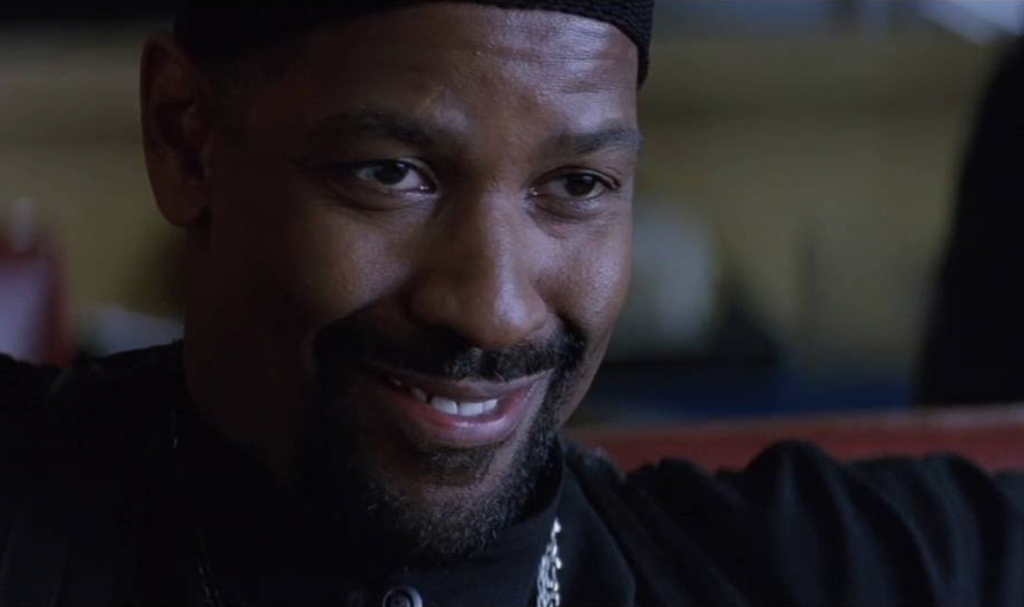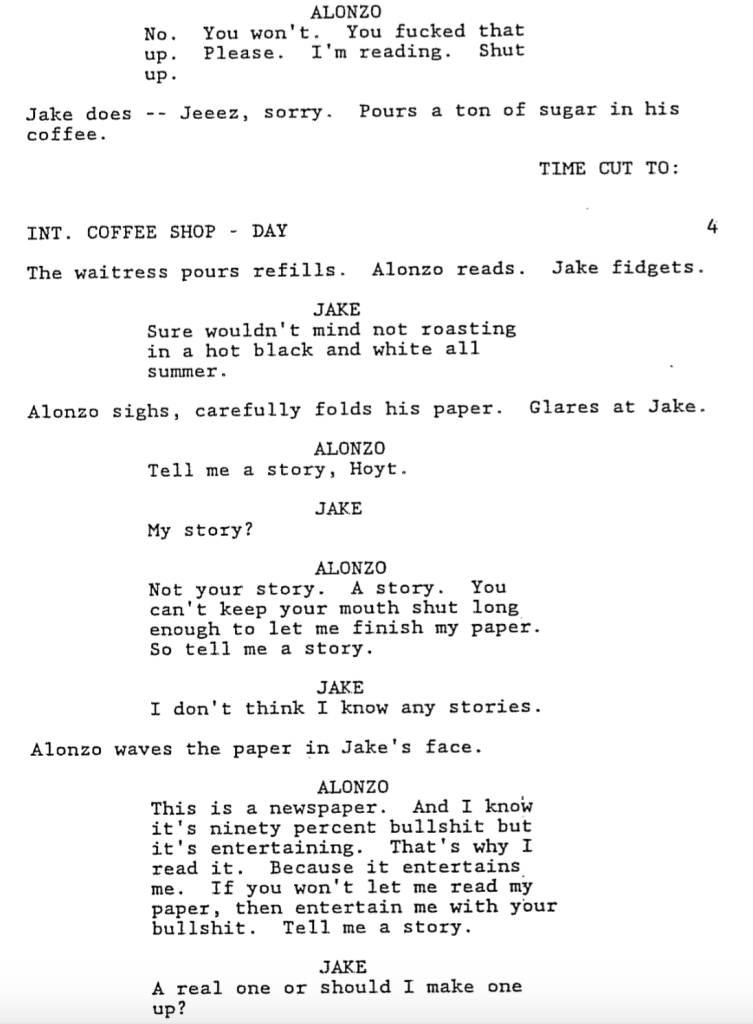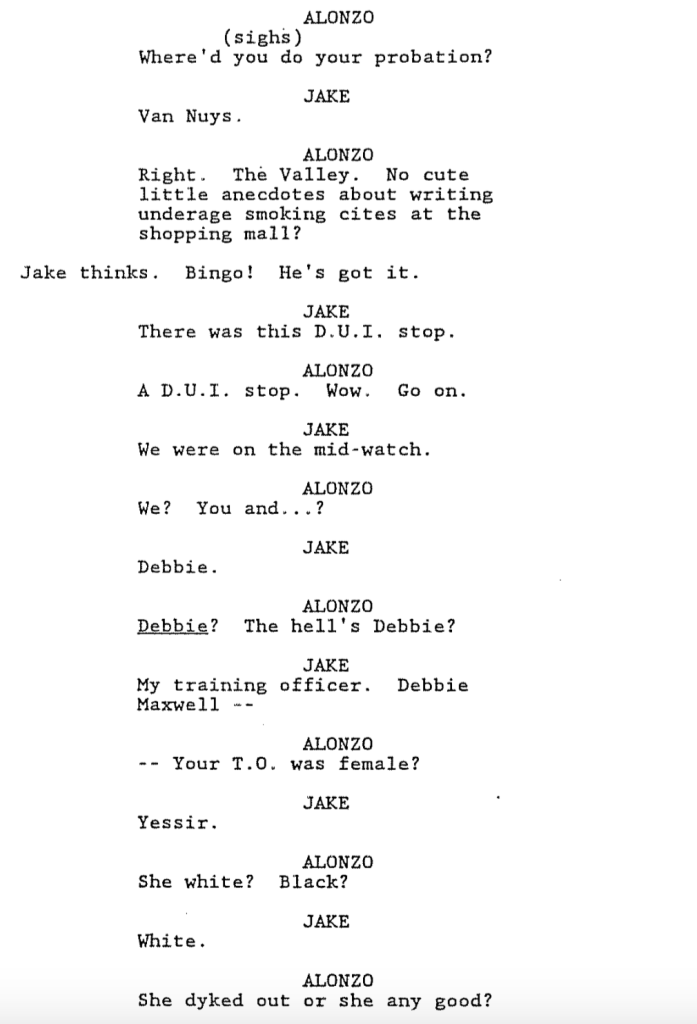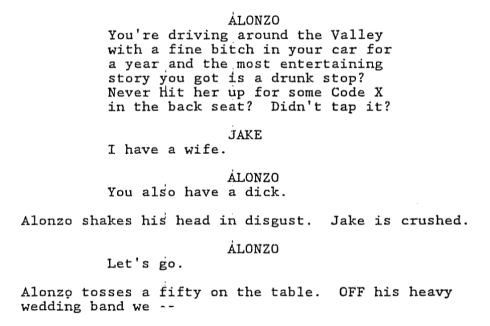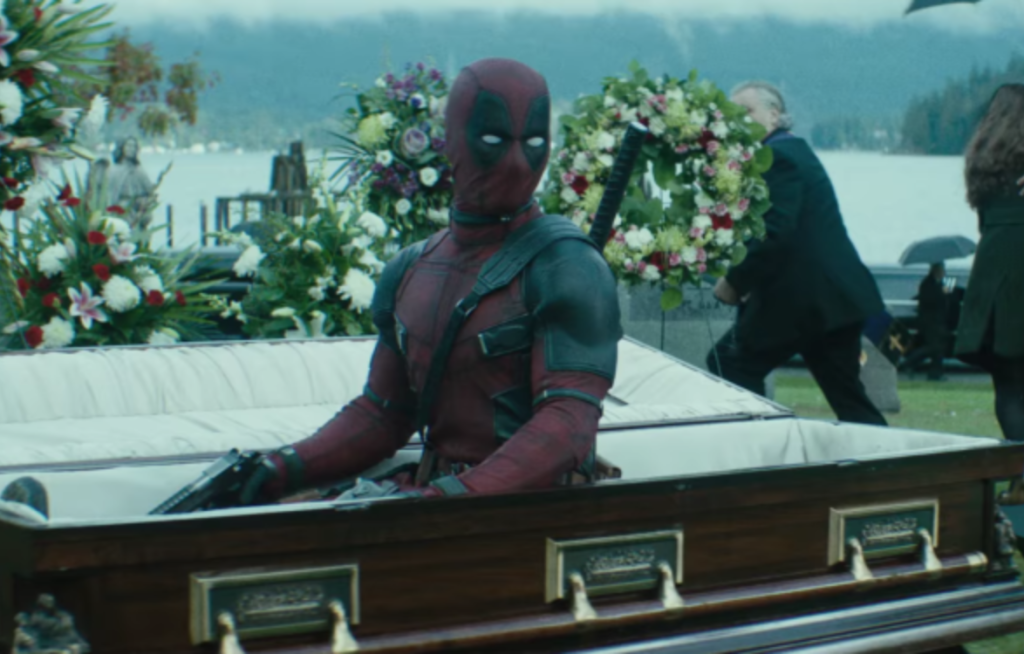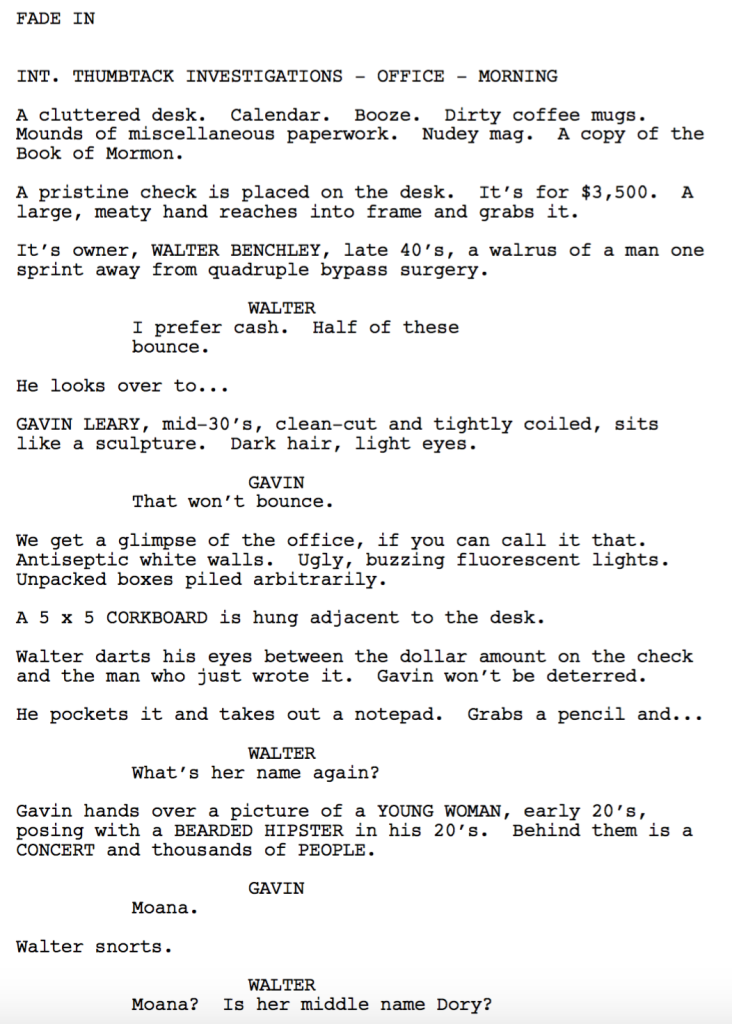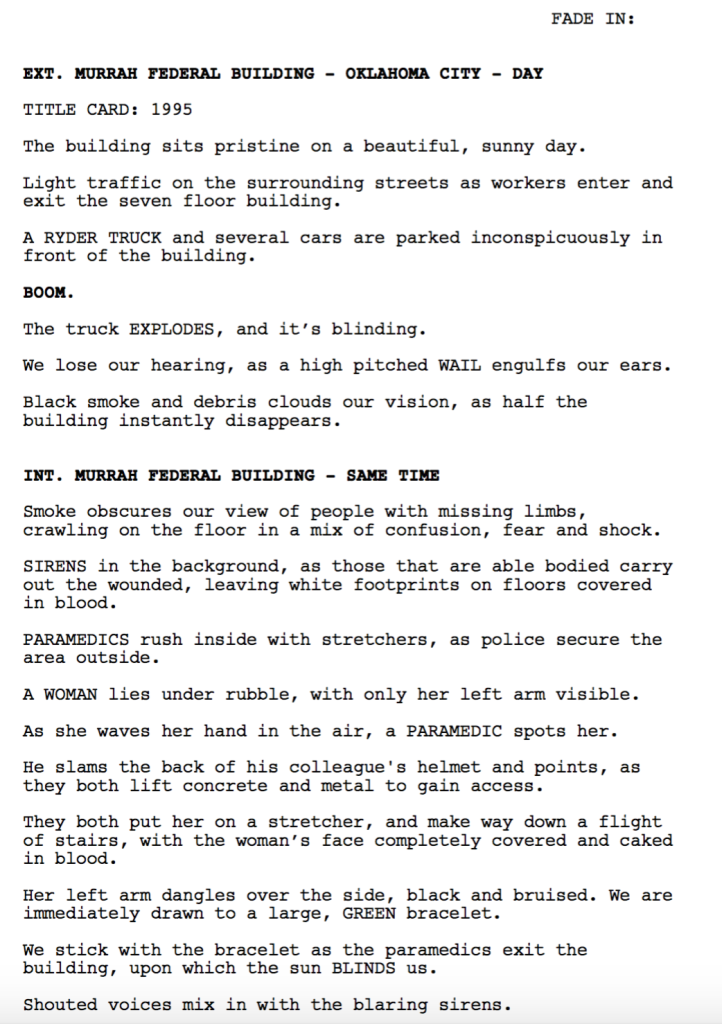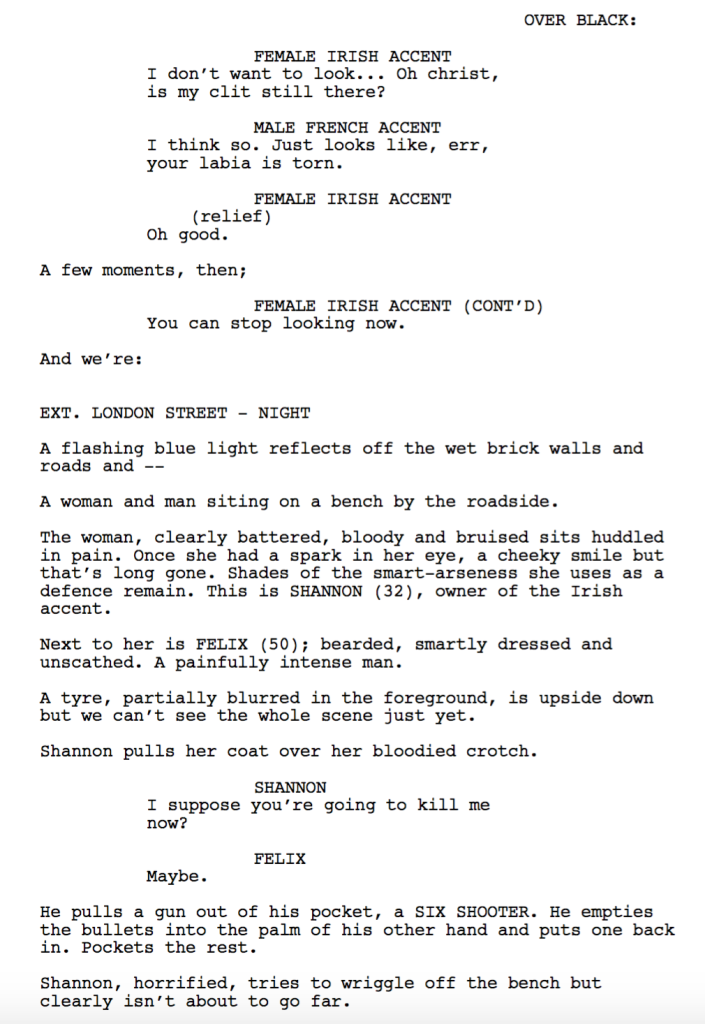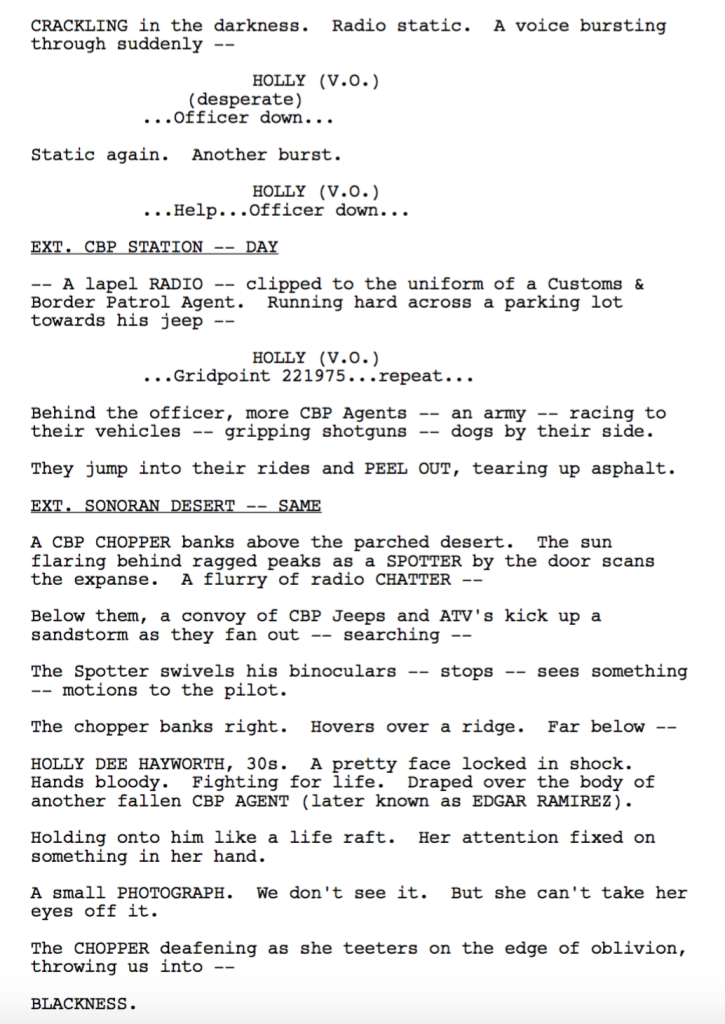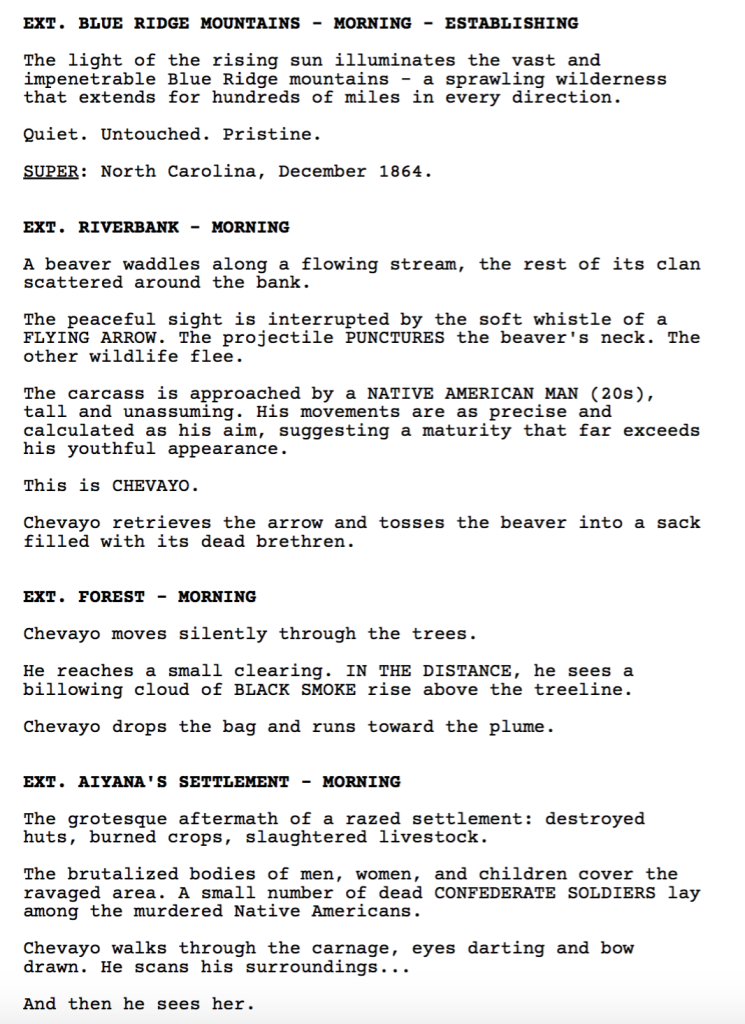Search Results for: the wall
DIALOGUE WEEK IS HERE! – All this week, I’ve been breaking down dialogue scenes from the movies you love. Monday’s Dialogue Post is here. Tuesday’s post is here. And yesterday’s post is here.
If you want to go to dialogue school, check out Training Day. It’s basically a 120 minute dialogue scene. Which brings us to our first lesson. Don’t focus on writing great individual dialogue scenes. Focus on creating great characters who can then write the dialogue for you. Alonzo is the ultimate dialogue-friendly character. And Jake is the ultimate straight man. Put those characters together and you have dozens of scenes where the dialogue writes itself. Let’s check out their famous first meeting together. For those who haven’t seen the movie, it’s about a young cop’s first training day with a veteran narcotics officer.
Okay, let’s jump into the easiest way to write a good dialogue scene. Are you ready? Give us one character who doesn’t want to talk and one character who does. That’s it! Boom! You do that, you will write good dialogue. I promise you. And that’s the whole premise of this scene. Jake wants to talk. Alonzo doesn’t.
I could stop there and you’d be halfway towards dialogue mastery. But I want to revisit this week’s theme. Which is that the best dialogue comes from what you’ve done BEOFRE the scene. Not during. We’ve built this entire movie around a dialogue-friendly character in Alonzo. He’s opinionated. He’s brash. He’s colorful. He’s un-p.c. He says the things you’re not supposed to say.
We then placed him across from a straight man. Dialogue-friendly characters work best with straight men. Two dialogue-friendly characters is like having two chefs in the kitchen. With that said, 2 DF characters can work. In Silver Linings Playbook, Pat and Tiffany were both dialogue-friendly and their scenes were great. But generally speaking, the rhythm of good dialogue follows a dominant and submissive pattern.
Which segues nicely into our next topic: power dynamic. Power dynamic is HUGE when it comes to dialogue. The very nature of somebody being “in charge” creates an imbalance. And that’s where the tension is. Tension is conflict. Conflict is drama. Drama is entertainment. In this scene, the power dynamic is obvious. It’s built into their job descriptions. But there’s a power dynamic to every conversation. Yesterday, the power dynamic was with the parents. They were in charge of the conversation. Chris was merely trying not to fuck up. In The Big Lebowski scene, Walter was on top of the power ladder, The Dude was in the middle, and Donny was on the bottom.
In this scene Alonzo’s power is SO MUCH HIGHER than Jake’s that Jake’s walking on eggshells the whole scene, which is what makes the conversation so fun. You can see Jake trying to say something – ANYTHING – to get Alonzo’s approval. If Jake and Alonzo are on the same power level, this scene doesn’t work.
It shouldn’t need to be said that dialogue reveals character. Which means you should be looking for opportunities to tell us about your character through the lines they deliver. Especially early in the screenplay, when we don’t know them yet. It just so happens there are a couple of prominent character revealing lines in this scene.
Alonzo is fed up that Jake won’t stop talking to him, so he demands that Jake tell him a story. Jake mumbles out that he does’t know any stories and Alonzo doubles down. Tell me a fucking story. “A real one or should I make one up?” Jake replies. I love this line because not only is it unexpected. But it reveals how indecisive and eager to please Jake is. I know everything I need to know about this character after this line.
Ditto Alonzo with his response to Jake’s story. Alonzo has no issues with telling Jake that his story sucked (he’s mean). And that getting laid is more important than preventing murder (seriously warped moral compass). In one sentence, we know just how screwed up and ruthless this man is. That’s good writing.
Let’s get into some minutiae. I love how Ayers says that Alonzo never stops looking at his paper during the conversation. It creates this literal barrier for Jake to bang up against for the first half of the scene. A lot of amateur writers assume you need to create the perfect circumstances for a conversation. It’s the opposite. You’re trying to find the angle that creates the most un-ideal circumstances for conversing. By forcing Jake to talk to a wall, it injects one more layer of conflict into a situation that’s already drowning in it.
Another example of this would be two people who meet at a loud club. They can’t hear each other. They have to keep saying, “What??” They misunderstand words, which leads to strange conversation tangents. That’s always going to be more fun than if they meet in a quiet room with no distractions.
I also love this exchange. “Have some chow before we hit the office. Go ahead. It’s my dollar.” “No, thank you, sir. I ate.” “Fine. Don’t.” Alonzo could’ve questioned what’s wrong with Jake here (“Who doesn’t eat at a diner?”). He could’ve challenged him (“You knew you were meeting me for breakfast and you already ate?”). Instead, he uses two words. “Fine. Don’t.” It’s savage. I actually shivered when I read those words. It’s a reminder that sometimes, the fewer words you use, the better. You don’t always have to craft a wonder-line.
Speaking of wonder-lines, there’s one flashy line in this scene. The newspaper line. And that’s appropriate. You shouldn’t be trying to win the lottery with every line. The very act of limiting yourself to one killer line ensures it will stand out. “This is a newspaper. And I know it’s ninety percent bullshit but it’s entertaining. That’s why I read it. Because it entertains me. If you won’t let me read my paper, then entertain me with your bullshit. Tell me a story.”
How do you write a line like this? Because I read a lot of amateur versions of this line. They come out more like, “Now you done fucked up. I can’t focus no more. All because you think you’re more entertaining than a newspaper. So if that’s what you think, then go ahead. Entertain me.” It’s clunky, not as clean. And doesn’t end with the same decisive POP that Ayers line does.
This is a case of a writer paying attention to his environment. You have this newspaper here. It’s already a major part of the scene. Let’s keep using it. But how can we use it to craft a great line? Start by asking questions. “What is a newspaper?” (It’s mostly bullshit) “Why is my character interested in this newspaper?” (it’s his calm before the storm) “What’s in here that he needs so badly?” (nothing really. But it’s one of the few things that entertains him. And since not many things entertain him, he values it).
You now have some PIECES you can use to form a line.
The answers to those questions pretty much form the basis of the first 75% of the line. Ayers then gives the line extra pop at the end by adding some wordplay. Entertainment and bullshit were featured words at the beginning of the line, so he brings them back at the end (“If you won’t let me read my paper, then entertain me with your bullshit”). There’s no science to this stuff but that’s one way of arriving at the line. Of course, for some writers, this stuff just comes naturally. Lucky bastards.
Finally, what I love so much about this scene is that while Denzel got a ton of credit for his performance, the truth is, it’s all there on the page. I don’t see that often. A lot of writers are wishy-washy and it opens the scene up for lots of interpretation. There’s no interpretation here. Any actor reads that beat of Alonzo keeping that newspaper up between him and Jake, and they know exactly who this character is and how to play him.
What I learned: Don’t over-describe pointless actions during heavy dialogue scenes. The less action you write, the more we can focus on what the characters are saying. Ayers writes barely any action here, and when he does, he keeps it to one line, except for a couple of times when it reaches one line and a quarter.
Now that you’ve read the scene, check out the finished product.
Genre: Superhero
Premise: When a time-traveler comes back from the future to kill the boy who murdered his family, it will be up to Deadpool and his new super duper team to stop him.
About: There’s a sneaky sub-story regarding today’s film that the trades are trying to sweep under the rug. Deadpool 2 made 125 million dollars this weekend. That’s 7 million dollars less than the first Deadpool made on its opening weekend. The trades hate when one of their darlings underperforms because it means they have to come up with an angle that excuses the performance despite a history of tearing apart films with similar results. The spin they’re going with here is that Deadpool did better globally in its first weekend than the first film did. But that’s largely because they opened on more screens this time around. The thing is, Deadpool 2 does deserve a pass. It’s a better film than the first one. Its underperformance is the doing of its studio, which placed it between Avengers and Star Wars, possibly the worst release date in the past 10 years. Why not place Deadpool in June where the waters are calmer? I don’t know. But Deadpool 2 will leave between 100-200 million dollars on the table due to this bizarre decision.
Writers: Rhett Reese & Paul Wernick and Ryan Reynolds (based on the comic by Rob Liefeld & Fabian Niciza)
Details: 2 hours long
BEEEEP BEEEEP BEEEEP. Backing up the Spoiler Truck guys. If you get run over, it’s your fault.
I have a lot to say about this one so let’s jump right into it!
Deadpool 2 starts in typical Deadpool fashion, with Deadpool blowing himself up. But the curse of being Deadpool is that he can’t die. So like Humpty-Dumpty, they put him back together again. A few scenes later, Deadpool shows us the reason he killed himself. A bad guy pops into his apartment and shoots Vanessa in the heart. Yes, Vanessa, from the previous film is dead.
Meanwhile some dude named Cable, who’s from the future, is also suffering from family tragedy. His wife and son were murdered by a firestarting super-villain. So Cable time-travels back to 2018 to kill the offending villain, a mutant 12 year old boy named Russell, before he can begin his decades-long killing spree that ends in the murder of his family.
Deadpool is reluctantly recruited into the X-Men, which means he has to do good, and his first order of goodness is to save Russell. But being Deadpool, he has to do things his way. So he recruits a team of the worst superheroes imaginable, calling them X-Force. It’s then a race for X-Force and Cable to see who gets to the boy first.

To stand out amongst an entertainment machine that pumps out thousands of hours of content every day, millions if you count the internet, when you write a script, you must give us things that we’ve never seen before.
That doesn’t mean you have to give us a movie concept we’ve never seen before. It’d be nice. That’s what the original Deadpool did. It gave us a fourth-wall breaking R-rated superhero. But it’s hard to find those ideas.
So the next best thing is to give us moments WITHIN YOUR SCREENPLAY that we’ve never seen before. One great original moment is nice. Two is better. And anything over two is awesome. Deadpool 2 gives us three moments.
The first is the opening credits scene. For those who haven’t seen the film, Deadpool’s wife, Vanessa, is killed in the fourth scene of the movie. It’s an emotional moment. I was genuinely shocked. These two were set up as the perfect couple in the first film.
The title sequence that follows, a James Bond parody set to a surprisingly catchy Celine Dion song, begins listing the credits. Except they aren’t what we expect. “Produced by: Wait a minute, did you just fucking kill her?” “Directed by: Are you insane?” Director of Cinematography by: “Holy shit, you really fucking killed her.” (paraphrased).
This was clever, not just because we’d never seen it before. But what you probably don’t know is that credit sequences are unionized. It’s hard to change them. Unions did this to prevent situations where producers kept their credit on screen for 60 seconds. Or say the studio hated the job the costume designer did. This would prevent them from simply not including her credit.
I bring this up because there’s a bigger issue at play here. There are things that we believe are “set.” That can’t be changed. So we don’t even consider it. I’m assuming the reason it took so long for someone to think of this was because everyone assumed you can’t change a title sequence. You had to accept them. This is a reminder that everything is open for change. There should be no avenue closed off from your imagination.
The second moment was the X-Force fail. This was my favorite sequence in the movie. I knew something was up because the superheroes looked super cheesy, even for a movie that made fun of superheroes. But I didn’t think they were going to kill them off before they fought a single battle! That was brilliant, and the one time in the movie where I couldn’t stop laughing.
Finally we had baby legs. I wasn’t a fan of this scene. A lot of people think the baby-adult hybrid thing is funny. They’ve done a lot of Super Bowl commercials covering it. But it’s too weird for me. Regardless, there’s a lesson to be learned here as well. This is one of the most talked about sequences in the film, and it’s six people in an apartment. This is what I remind writers who think that the only way to catch a reader’s attention is to go bigger. No. This scene proves that the smallest scenes can be the most memorable. You just have to be creative.
But maybe the biggest surprise of Deadpool 2 was how character-driven it was. I’d just done a screenplay consultation for a writer who wrote an action film. And my big note to him was, “You need to give us more character development so that we care about these characters during the action.”
As I was writing that, I realized that the average screenwriter has no idea how to do this. Their understanding of character development in an action film is to write one scene every 30 pages where two characters are in a room, resting, and one of them gives the other a monologue about their troubled childhood.
Deadpool 2 is about 30% action. This means 70% of the film is covering character. Seeing Cable’s reaction to the aftermath of his dead family is character development. Deadpool whining to a bartender after his wife died is character development. Seeing quick flashes of Russell being tortured is character development. Seeing Deadpool rage-kill the man who killed his wife is character development. Deadpool and Cable having a difference of opinion on how to treat Russell is character development. Cable carrying around his boy’s burnt stuffed bunny is character development. Deadpool’s dreams where he’s back with his wife are character development. Russell desperate to find a friend he can trust is character development. In fact, Russell’s entire character (a boy who’s been abused his whole life and is now taking it out on the world) is character development.
I reminded the writer that anybody can write action. But very few writers can develop character. That’s the hot commodity in screenwriting. If you can do that? Hollywood will hire you from now until the end of time.
As much as I admired the crafting of Deadpool – the chances it took and the overall writing – I did have one problem with it. Its biggest strength – Ryan Reynolds – is also its biggest weakness. The fourth-wall-breaking joke-a-minute schtick is tiring. It’s so tiring. Yes, Deadpool does it better than anyone. But it’s still a gimmick. And gimmicks have short shelf lives. Note how in Ferris Bueller, Ferris only does the fourth wall breaking in that opening sequence. During the rest of the movie, it happens only a handful of times. And that’s because John Hughes knew that the audience would get tired of it. Deadpool’s commentary started to irk me towards the end. And that’s the only reason this movie doesn’t finish with an impressive.
[ ] What the hell did I just watch?
[ ] wasn’t for me
[xx] worth the price of admission
[ ] impressive
[ ] genius
What I learned: Action films have way less action than you think they do. It’s roughly around 30% of screen time, usually less. Let this be a lesson that you need to learn to develop character if you’re going to be a successful writer in this genre.
We’re so close to Avengers Infinity War I can taste it like I can taste a ripe tomato on a freshly fried In and Out burger. I can feel it within my talons – the biggest superhero movie ever made. Yet I have to wait an entire week to sample the goods!? What country do I live in! Syria!? I have no doubt life hates me. And on top of that you casually drop the news that the Kardashians have closed all their Dash stores?? Where is a fashion-conscious person supposed to shop dammit!!! It’s like I’m literally watching Armageddon rain down around me.
Which is why I’m so so happy to interrupt this awful news with… (shouting from the rooftops voice) “AAAMMMMMATEEEEEUR OFFFERRRRINGS!” It’s the place where you, the mild-mannered screenwriter, the little guy with a big idea, can be featured in a one-weekend battle royale style tournament, and IF YOU WIN, you get a review on the site next Friday. What could that review lead to? Try money. Fame. Hundreds of adoring Twitter fans. I call that the sweetest deal on the internet.
Don’t be shy folks. If you believe you have a screenplay that is reverse-Armageddon worthy, submit it for a future Amateur Offerings! Send me a PDF of your script, along with the title, genre, logline, and why you think people should read it (your chance to pitch your story). All submissions should be sent to Carsonreeves3@gmail.com.
Rules of amateur offerings: Read as much as you can from each script and vote for your favorite in the comments!
Title: Messiah Complex
Genre: Crime/Thriller
Logline: A Salt Lake City P.I. is put directly in the crosshairs of a deranged cult when he’s hired to find the sister of an ambitious public official.
Why You Should Read: I’ve been sending this one out to contests after it got decent coverage. Eager to see what the scriptshadow community thinks. If you like neo-noir, mystery, dark humor, cults, etc., you’ll enjoy this incredibly twisted rabbit hole. Hard-boiled, quirky, and even shocking.
Title: Murder In Grave
Genre: Thriller
Logline: Facing the prospect of permanently losing her hearing, a music teacher gets an artificially intelligent cochlear implant that convinces her to commit mass murder.
Why Should You Read? What would you do if the only thing that gave you meaning in this world was to be taken away forever? — If there was an experimental procedure, with untold risks, that could prevent that scenario, would you undertake it? — Murder In Grave is a slow burn thriller, that has been crafted with the sole purpose of emotionally strangling the main character from page one until fade out. A hurdles race where the obstacles get higher and faster the further you go on. — Naturally, as the stakes increase, something always has to give.
Title: Bet Your Life
Genre: Dark Comedy
Logline: A suicidal gambling addict is drawn into a plot to rob the betting office she used to own.
Extended logline: … But between her dysfunctional support group friends, an ex-fiance who doesn’t want her back, a magpie that won’t leave her alone and a dice-wielding, luck-obsessed psychopath, it appears that Lady Luck may have other plans for her life.
Why You Should Read: This is that script that I’ve never been able to cut my losses on (ironic and topical). And recently, after a creative buzz, I tore off my shackles, leaned into my weirds and killed a few babies (in screenwriting terms only, I’ve only killed one baby* in real life, and that was an “accident” – we’ve all been there, an annoying baby screaming in his pram, the top of a grand staircase and Leslie Nielsen nowhere in sight and whoops an “accidental” passing nudge). Anyway, I digress….
This script is very In Bruges-y in tone, part comedy, part drama but with female central characters. It draws heavily on themes of luck and addiction with some serious scientific examination thrown in for good measure… That being how high up you’d need to be to guarantee instant death if you threw yourself from a building. Important stuff. — As for me, I’ve been writing (in my spare time) for nearly ten years. I have a receipt from a UK University saying this is more than a just a hobby so I hope to tickle your fancy, your balls and/or your boobs (yes, potentially both. Inclusive, so…) and invite you to indulge in my script.
*That baby was really ugly. And he had the look of a baby who would grow up to kill babies.
Title: Sentinel
Genre: Sci-Fi Thriller
Logline: After the U.S. government unleashes a terrifying secret weapon to hunt down illegal border-crossers, a female border agent is forced to work with a vicious cartel gangster to ferry a young migrant to safety.
Why You Should Read: Sentinel was a semifinalist at the 2012 Nicholls and came in 2nd place in the sci-fi/action category at the PAGE Awards. This script landed me a manager and was sent around Hollywood. (The logline was actually selected by Scriptshadow in a Top 100 loglines contest–it was called Coyote back then). — Sentinel received a lot of great responses from agents and producers but back in 2012-13 the general consensus was that illegal immigration was not a saleable concept. Well fast forward to 2018 and Trump is building a wall and movies like “Get Out” and “A Quiet Place” are proving that tough topics and sci-fi monster stories are alive and kicking. — Sentinel is a tight, relentless thriller that tackles racism, illegal immigration, and redemption in a bold new way. I think Scriptshadow readers will really enjoy it.
Title: Skin and Sinew
Genre: Historical Thriller
Logline: When a Confederate raid on his small Native American tribe results in the death of his Queen and people, an ancient creature with the ability to assume any human form embarks on a mission to hunt down the general responsible for the massacre.
Why You Should Read: If I were to play the comparison game and elevator-pitch my movie, I’d say it’s “Under the Skin” meets “The Revenant.” Set during the closing years of the American Civil War, “Skin and Sinew” is brutal, violent and grim; a down-and-dirty B-movie revenge story not unlike the classed-up exploitation flicks that S. Craig Zahler has excelled in. If you’re looking for a head-smashing, bone-crunching good time, give this bad boy a shot. Many thanks to anyone willing to check it out; I look forward to reading what the community (and, God willing, Carson) has to say about it!
Genre: Sci-Fi
Premise: (from IMDB) When the creator of a virtual reality world called the OASIS dies, he releases a video in which he challenges all OASIS users to find his Easter Egg, which will give the finder his fortune.
About: Time to answer that question I asked a couple of months ago. Which movie will do better at the box office? A Wrinkle In Time or Ready Player One? RP1 took in 53 million this weekend. If you look at percentage return on investment when compared to A Wrinkle in Time, (Wrinkle’s budget was 100 million, RP1’s was 175 million), Wrinkle actually fared better on its opening weekend. We called that movie a bomb. So this has to be a bomb too, right? I would say that RP1 isn’t so much a bomb as it is a grenade. The reason being that RP1 is going to do way better internationally than A Wrinkle in Time, which should make the film profitable. Wrinkle in Time, however, will be a loss for Disney. That’s not to say RP1 hasn’t used some trickery to make its less-than-stellar opening weekend look better than it is. RP1 opened a day earlier than usual (on Thursday) AND got an extra day after the weekend with the holiday (Monday). This helped them to claim a “weekend” haul with two extra days’ worth of money lumped in. Looks like the Easter Bunny isn’t the only one hiding a few extra eggs around the yard. The reality is, when WB did their pre-film projections, they were banking on a 75 million dollar opening weekend AT LEAST. And if you look at it that way, RP1 is a financial disappointment. But is the movie actually good!? That’s the ultimate question. Let’s find out.
Writer: Zak Penn (based on the novel by Ernest Cline)
Details: 140 minutes
/cdn.vox-cdn.com/uploads/chorus_image/image/59124873/RPO_TRLR_0173.0.jpg)
I’d heard some disappointing things leading up to the release of Ready Player One, the most frustrating of which was that Steven Spielberg went off and shot The Post while Ready Player One was being edited.
Some of you may see this as a non-story. But to me it’s everything. One of the biggest issues with Ready Player One is that it’s all over the place. And because its subject matter made it particularly susceptible to being “all over the place,” it needed someone who was 100% committed to keep it on track. If Spielberg was shooting The Post while Ready Player One was being edited, it meant he was also involved in pre-production and casting and scheduling and meetings for The Post while Ready Player One was being shot. His mind was in two places at once. Which is why this movie feels so scattered.
Problem #2: Spielberg gave a Ready Player One promotional interview where he was asked about getting the rights to all the properties in the rights-heavy film. Spielberg responded with a befuddled, “Oh yeah, I didn’t deal with that. The studio people were in charge of all that.” I’m sorry but whhhhuuuhhh did you just say? Shouldn’t you be the one leading the charge on this!? Not just because getting the rights was everything with Ready Player One, but because you’re STEVEN SPIELBERG and can get anything you want.
Because here’s the thing. The novel for Ready Player One was all about Halliday’s love for the 80s. I know nostalgia is controversial right now but the 80s were the heartbeat of this book. Halliday built the Oasis as a way to live forever as a child in that decade. So there was thematic unity – From Pac-Man to Back to the Future to Tears for Fears – in every pop culture reference. By contrast, this movie is a mish-mash of whatever the hell pop culture references you can think of over the last 40 years, which contributes to the pervasive messiness. I mean Iron Giant missed the 80s by a decade! Why is he featured in this??? It’s so random.
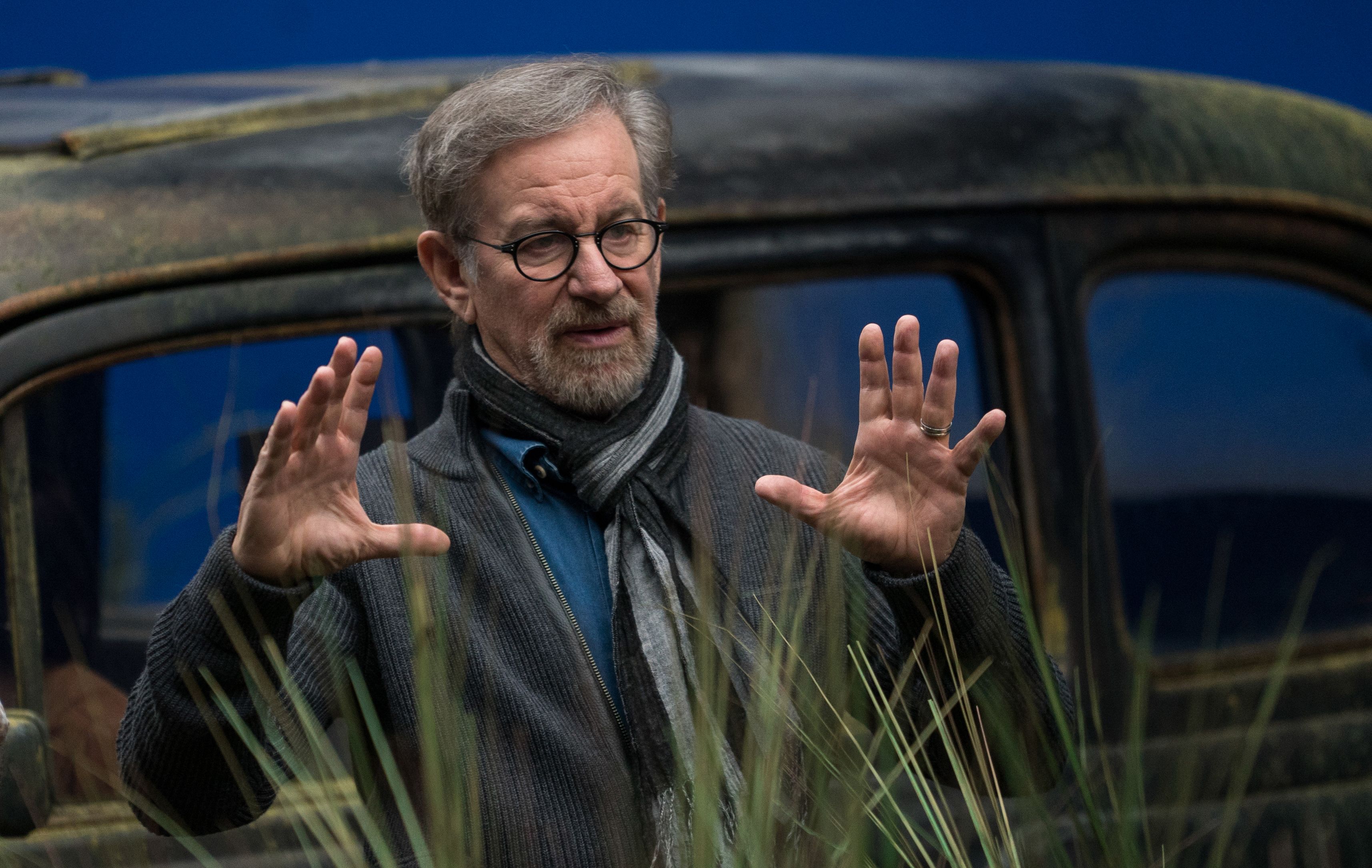
A more dedicated director would’ve put his foot down and said, “No. It doesn’t make sense if it’s ALL pop culture. It needs to be pop culture from ONE SPECIFIC time period.” There’s some SUPER GEEKY screenwriting history connected to all this. Zak Penn, the screenwriter who adapted RP1, is forever enshrined in screenwriting lore for losing his shit after his breakthrough spec, The Last Action Hero, was rewritten to expand the 80s pop culture movie references Penn had based the movie on, to movie references from every era. I’m getting off track though, just like Spielberg! So let’s loop back.
For those of you who don’t know anything about Ready Player One, it’s set in 2040-something, and focuses on a world that spends the majority of its time inside the “Oasis,” basically the virtual version of the internet.
Wade (or “Parzival” as he’s known in the Oasis), our plucky teenaged hero, is one of millions who are hunting for three keys inside the Oasis by its since-deceased creator, Roy Hallidy. Hallidy wrote into his will that whoever finds these three keys will inherit the Oasis itself, which is worth in the neighborhood of a trillion dollars.
With his two best friends, the super-hot Art3mis and the super-cool “H,” Parzival must hold off the evil organization, IOI, from finding the three eggs first and turning the Oasis into a heartless money-thieving conglomerate.
So Spielberg didn’t get the big picture stuff right. What bout the characters? Let’s start with Parzival. In the book, Parzival was a walking nobody in the real world. So when he gets that first key and becomes an instant Oasis celebrity? It felt like something huge had happened. Imagine being no one and then becoming the most famous person in the world overnight. The book documented that transition beautifully. In the movie, this was lost. Parzival’s introduction is used strictly to dish out narration and set up the rules of the universe. As a result, we never feel like we know Parzival. And that’s been reflected in how people have reacted to Tye Sheridan’s performance. It’s all very polite. “Yeah, it was okay.” And that’s because they botched the setup for this kid.

One of the oldest screenwriting tips in the book is to “establish your character’s normal world before throwing them into the crazy world.” Look at one of the inspirations for Parzival, Marty McFly. In Back to the Future, we see Marty McFly at school, we experience his aspirations to become a rock star, we get to know his girlfriend, we hang out with his weirdo family. We see HIS NORMAL LIFE. Therefore, when he’s thrown into the crazy world (the past), we have something to contrast it with.
That never happens here. Parzival’s “normal life” is limited to a quick slide down a pole and a giant glob of narration that has nothing to do with him. We’re into the Oasis before I even know if Parzival goes to school or this is summer break or what he does with his average day. This is an admittedly different situation from Back to the Future. An argument can be made that the Oasis IS the “normal world” of this reality. But if I was guiding this project, I would’ve established more of Percival’s real world life first. I never truly connected with him and I have a sneaking feeling that was the reason.
Where Ready Player One really falls apart, however, is in the second half of its second act. The characters are all having realizations that none of us are in on (the equivalent of: “Halladay’s pocket protector wasn’t protecting his pocket. It was protecting the planet.” “So you’re saying we need to go to the Zanzibar System?” “Yes!”), the muddy rule-set of the mythology is getting muddier with every scene (If a bad guy dies in the Oasis, his perfectly healthy real-world counterpart has to be replaced with someone else??), and a climax is birthed out of thin air (Uh, I guess we’re all trying to stop the bad guys from playing Atari 2600!).
It’s a shit show.

And looking back on it, Spielberg’s visualization of the Oasis itself is a metaphor for the screenplay. The virtual world of the Oasis is dark, muddy, and unflattering. Which is exactly how this story is treated. You could never quite see what was going on through all the haze. I mean that opening car race scene, which I featured in my screenplay review as having the potential to be legendary, was a giant piece of Transformers-inspired tomfoolery. You never knew what was going on because the camera was always zipping between every street corner, wrecking ball, giant gorilla, and T-Rex it could find. There isn’t a SINGLE CLEAN SHOT of the action. And it made me sad. Steven Spielberg taking his directing cues from Michael Bay? What has this world come to?
/cdn.vox-cdn.com/uploads/chorus_image/image/58996083/cars.0.png)
There’s a moment deep in the script where our five heroic avatars meet each other in the real world for the first time. In an INSTANT the movie came alive. Gone were upside-down gravi-dancing set pieces and in their place were simple medium and close up shots of REAL PEOPLE. Who were playing off each other. Who were having REAL MOMENTS. You could feel how comfortable the director was. It was like, “Where the hell has this been all movie?”
I get it, guys. It’s a movie that takes place in a virtual world. You can’t have a ton of real-world scenes. But the reason those scenes popped was because they were based in simplicity. There was no nonsense going on. It was pure character-driven storytelling. And that’s what we needed more of in the movie, whether that meant more real-world scenes, or applying that ‘simple’ mindset to the Oasis.
I’ll finish off with something that’s going to nip your belt buckle but who am I if I’m not being honest? This is trigger-bait folks. Read at your own risk. Ready? I didn’t like the Shining sequence. This is the sequence everybody’s talking about and I know firsthand people loved it cause audience members were going crazy for it in my screening.
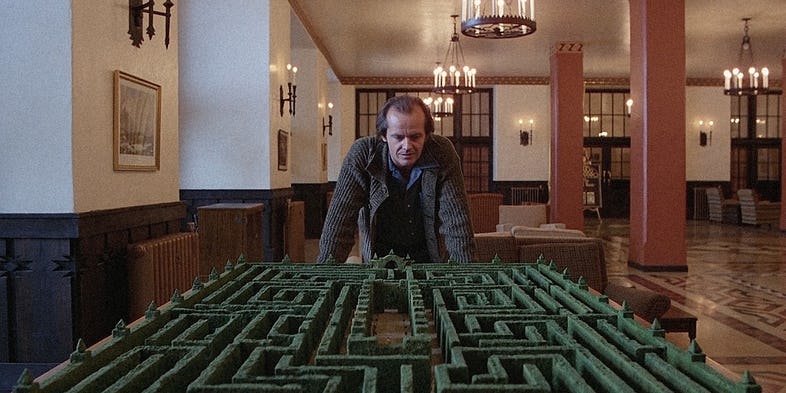
But to me the sequence confirmed why Spielberg doesn’t get the material. The Shining, while released in 1980, is considered by everyone to be a 70s movie. That’s how it identifies. And it’s not what Cline had in mind at all (the sequence wasn’t in the book). Because I’ve read a million articles on Spielberg, I know he’s a Kubrik fanatic, and that this sequence had nothing to do with what was right for the movie, and everything to do with a director who selfishly wanted to recreate one of his directing crush’s famous sets.
Don’t get me wrong. The sequence works in a vacuum. But it doesn’t fit into the whole. It contributes to the “anything goes” mentality where nothing in this film needs to connect, either logically or thematically. The Shining in the same movie as Iron Giant? What??
So is the movie bad? No, the movie isn’t bad. What it is is average. It has a few moments. The stuff in the real world where you could actually see people interacting and expressing emotion was when the film worked best. But the Oasis should’ve been crisper. And cooler! Parzival should’ve been better-constructed. And the screenplay needed to be simplified. The more I think about this, the more I think it should’ve been a TV series. It needed time to breathe and the feature format wasn’t going to allow that. There were a couple of fun scenes here. But Ready Player One was a mess in the Scriptshadow notebook.
[ ] What the hell did I just watch?
[x] wasn’t for me
[ ] worth the price of admission
[ ] impressive
[ ] genius
What I learned: Establish your “normal” world before sending your hero and the audience into the “crazy” world.
Genre: Drama
Premise: A former Navy SEAL and his retired combat dog attempt to return to civilization after a catastrophic accident deep in the Alaskan wilderness.
About: Today’s script comes from Cameron Alexander. It finished on last year’s Black List with 9 votes. The script sold to the producer of Beasts of No Nation, who, I guess, is cornering the market on scripts with ‘beast’ in the title. This is not Alexander’s first sale. He also sold a sci-fi spec back in 2013 called Omega Point. Alexander used to hang out on these boards before his success. Great motivation for those of you wondering when your shot is coming. :)
Writer: Cameron Alexander
Details: 100 pages

If you’re having trouble keeping your writing lean, stop what you’re doing right now and read this script. It’s a great example of lean to-the-point writing that isn’t SO lean that it lacks substance.
One of you brought up in the comments section the other day that producers only wanted to read super-lean screenplays, scripts they could shoot through in 30 minutes. I don’t think that’s true. One look at the Black List and you’ll see that there’s all sorts of writing.
Also, a good writer can make a dense story read lightning fast while a bad writer can make a balls-to-the-wall thriller read like molasses. In the end, it’s the writer’s skill that matters most.
With that said, when it comes to screenwriting, you should always err on the side of less, not more. And today’s script is perfect for getting you into that mindset. Let’s take a look.
James is a former Navy SEAL who’s had such a rough go of it that all he wants to do is get away. So he straps his combat dog, Odin, into his Cessna, and flies off to the last place in America totally free of people – Alaska.
These two frazzled vets can’t knock the military out of them. They still look around every corner as if it’s a potential threat. But, for the most part, they’re happy. They catch a couple of salmon, drink a couple of beers (well, James does anyway) and celebrate the last great frontier.
The next morning, after they hop in the Cessna and lift off, James starts feeling a pain in his arm. The pain gets more intense until he realizes what it is – A HEART ATTACK. James does his best to fight through it before falling on the yoke, sending the plane down.
The plane crashes into a lake, Odin is thrown into the forest, and James only barely makes it out alive. Convinced Odin is dead, James is ecstatic to find that he’s hanging on. James knows that he must quickly build shelter from the cold or the two will die, a task complicated by the fact that if he works too intensely, he’ll have another heart attack.
The two make it through the night. But now the real shit begins. James looks at his Alaska map to find that they’re 50+ miles from the nearest highway. They will need to traverse difficult terrain on limited rations, both in sub-optimal health, if they’re going to see anything other than pine trees and mountain tops again. Let the journey begin.
As a writer, I’m terrified of these premises. When all you have is one person and a basic survival story, there aren’t a whole lot of things to draw from that the average audience member hasn’t seen before. In Cast Away, you had the added hook of a deserted island and the help of the FedEx boxes. In The Martian, you had Mars. Here, you have trees and bears. Not to mention, you’re competing against movies with 50 superheroes in them.
So how do you combat that? Well, you start by asking what you can give the audience that movies like The Avengers can’t. You don’t have gimmicks. But you do have universal themes. Love. Survival. Never giving up. So you lean into those. There’s never going to be a moment as heartfelt in Avengers: Infinity War, for example, as the moment James realizes Odin is still alive after the plane crash.
Here’s a screenwriting trick that everyone should keep in the back of their mind. We’re always going to root more for somebody if there’s another character who loves them. The reason for this is that we see the character through that second character’s eyes. So we don’t just see James. We see James through the eyes of this dog who loves him more than anything. And vice versa. If either one of these two die, it’s not that we ourselves will be sad. We’ve only known these characters for 80 minutes. It’s that we’ll be sad for the character who lost them, since they’ve known them their whole life.
With that said, as I was reading through Heart of the Beast, I kept saying to myself, “This isn’t enough. This isn’t enough.” Audiences these days have so many options. How is a movie about a guy and a dog walking through Alaska going to compete?
And then I read the ending.
Holy. Shit.
Wow. Right after I read it, I knew: OHHHHH! THIS is why this sold.
It was no longer even a question.
If you’re interested in what that ending is, I beg of you not to jump right to it. It’s NOT a fancy twist ending. It’s just an intense one. And it only works if you’ve read the script all the way through. Which isn’t a chore at all. This script is one of the faster reads you’ll read this year.
Check it out and share your thoughts in the comments.
[ ] What the hell did I just read?
[ ] wasn’t for me
[xx] worth the read
[ ] impressive
[ ] genius
What I learned: In any sort of survival story, you want to CONSTANTLY THROW OBSTACLES in your hero’s way and CONTINUALLY REINFORCE THAT THE JOURNEY IS IMPOSSIBLE. If you nail those two things, we’ll stay riveted.

